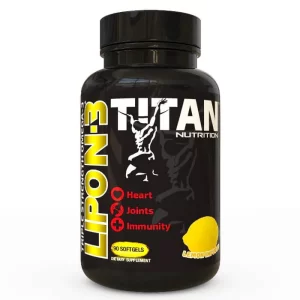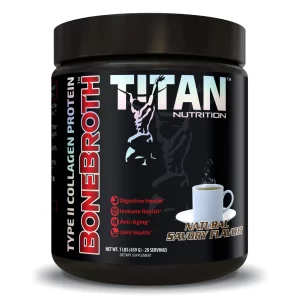by Mitch Hauschildt, MA, ATC, CSCS
Note: In this blog series on optimizing tissue healing, we will be looking at food, nutrients and supplements. We will be discussing products from our partner, Titan Nutrition. The owners at Titan are longtime friends and they make superior products at a great price (message me for a friends and family discount). You can explore their products or use another brand. It is completely up to you.
We often look at the world of physical rehabilitation and think about clinicians healing their patients. We like to think that we, as caretakers, are responsible for healing their injury or ailment. But the reality is that WE DON’T HEAL ANYONE FROM ANYTHING!! Our job to is set up the environment to allow for healing to take place. That’s all that our fancy tools and modalities are designed to do.
Unfortunately, one thing we often forget about in this conversation are the foods that we consume. They play an important role in tissue healing and they should be part of our regular conversation with our patients. I’m not over here pretending to be a registered dietitian or anything like that, but I do think that if we can take a few minutes to have a quick conversation with our patients about what they are consuming, it will make a difference in our patient outcomes.
Setting Up the Ideal Environment
The lens we need to look through for this conversation is the idea that we are trying to do everything that we can to make the ideal environment to promote tissue healing. This means that our patients need to get enough quality sleep, reduce their stress, and make good overall healthy choices. When the environment is right, the body is able to dedicate every ounce of energy and resources to the task at hand…healing. If the system is fighting fatigue, a poor immune system and so on, it has to split its resources, compromising tissue healing.
The goal of this blog series is to provide some ideas and insights that can be used as part of our conversations with our patients to help them heal quickly.
Omega-3
With the western diet, it is well known that we have very poor sources of omega-3 fats. They are typically found in things like fish, nuts and avocados, but even those sources are now being shown to have less omega-3’s than they did years ago. This is likely due to changes in farming and how we harvest and grow these items.
Omega-3’s are important for tissue healing because they help to offset omega-6 fats, which tend to create a lot of inflammation within our bodies. Unfortunately, most of us in the western culture walk around with a constant level of inflammation within our bodies, which can hinder the healing process.
Controlling inflammation with our diet is kind of an interesting topic, in my opinion. The reason that I say that is because I have become less and less of a fan of NSAIDs over the years because research is demonstrating that we don’t want to slow the inflammatory process. Rather, we want to optimize it after an injury, because the inflammatory process is necessary to heal. Because NSAIDs slow the inflammatory process, in theory, it can be detrimental to tissue healing.
So, if we use things like an omega-3 supplement to reduce inflammation, will that actually slow tissue healing? The overall answer, generally speaking, is no. Omega-3 supplements aren’t going to reduce inflammation enough to slow tissue healing. What they will do, however, is reduce inflammation enough that our body’s systems aren’t going to have their resources split in multiple directions. The body will be able to focus its resources on healing because it isn’t constantly being bombarded with inflammation from all directions.
Much like other areas that I have discussed in this blog series, I would prefer that my patients get their omega-3s through their diet, but many of us struggle to get there. So, for a lot of my patients, I do recommend a supplement to optimize their omega-3 intake in an effort to maximize tissue healing.
Collagen
Collagen supplementation is a little bit of a newer idea to most people, but supplementing collagen can play an important role in healing from things like tendon and ligament issues and surgical procedures. What the science is showing is that collagen supplementation (specifically type 2 collagen) is effective at healing soft tissue injuries.
A great source of type 2 collagen is bone broth. Once upon a time, humans consumed a lot more tissue of animals than they do now. Today, we tend to just eat the meat. We used to consume more of the tendons, ligaments, organs and cartilage. Now we cut that out as waste in the form of gristle. Unfortunately, those items are rich in vitamins, nutrients and things like collagen.
The easiest form of type 2 collagen is a high-quality bone broth. That doesn’t mean the little cubes that you can put in water to turn in brown and taste salty. Those are filled with artificial flavors and have little to no collagen. You need a true bone broth that is made from the stuff left over after the meat is removed.
Luckily, most bone broth supplements also contain a pretty good source of protein. So, if you go back to my earlier post on protein needs to optimize tissue healing and feel the need to add more protein to your patient’s diet after an injury, you can knock 2 things out with 1 supplement.
Conclusion
Throughout this series, we have looked at several items that we need to consider if we are interested in optimizing tissue healing, including protein, calories, micronutrients, probiotics, collagen and omega-3s. My hope is that you don’t go out and buy supplements for each one of these and start taking an extra 18 things at the same time. Take a look at each item and figure out which area you are most deficient in and start there. Look for the low hanging fruit.
Find ways little ways to optimize your diet to help with tissue healing. You will be surprised how big of a difference it will make.


Leave a Reply